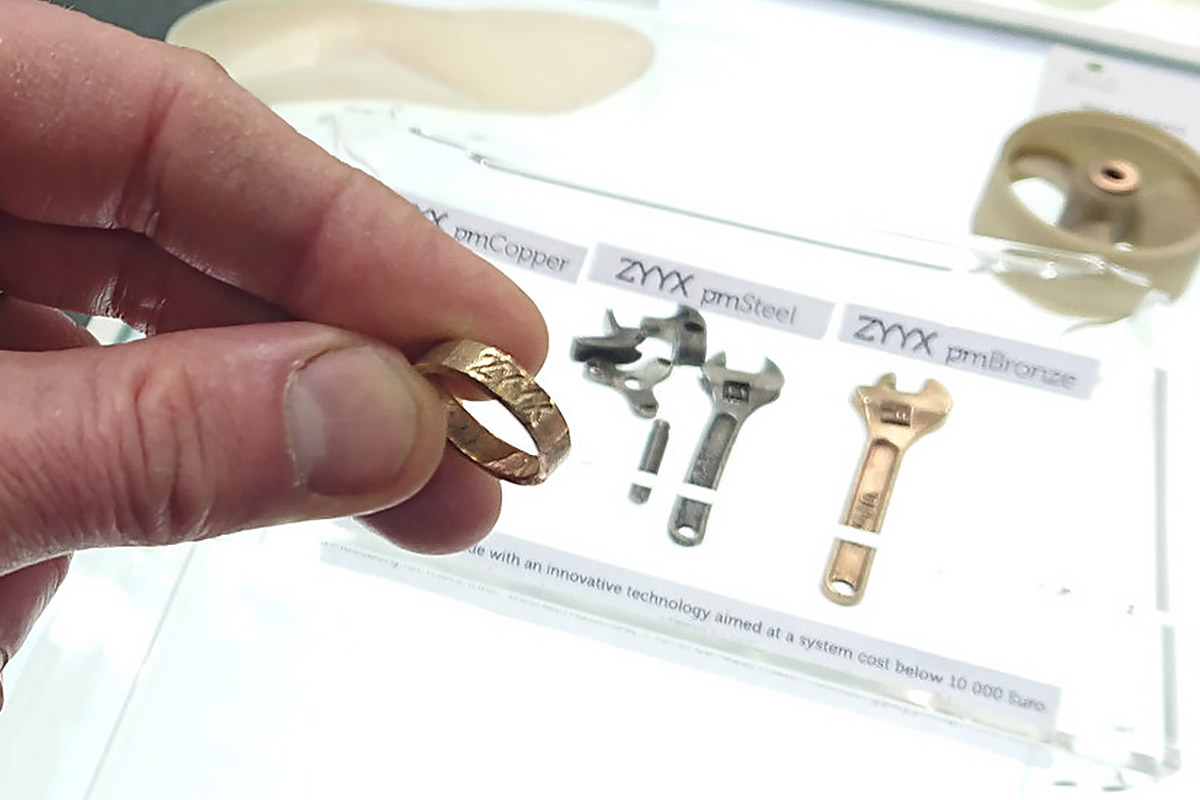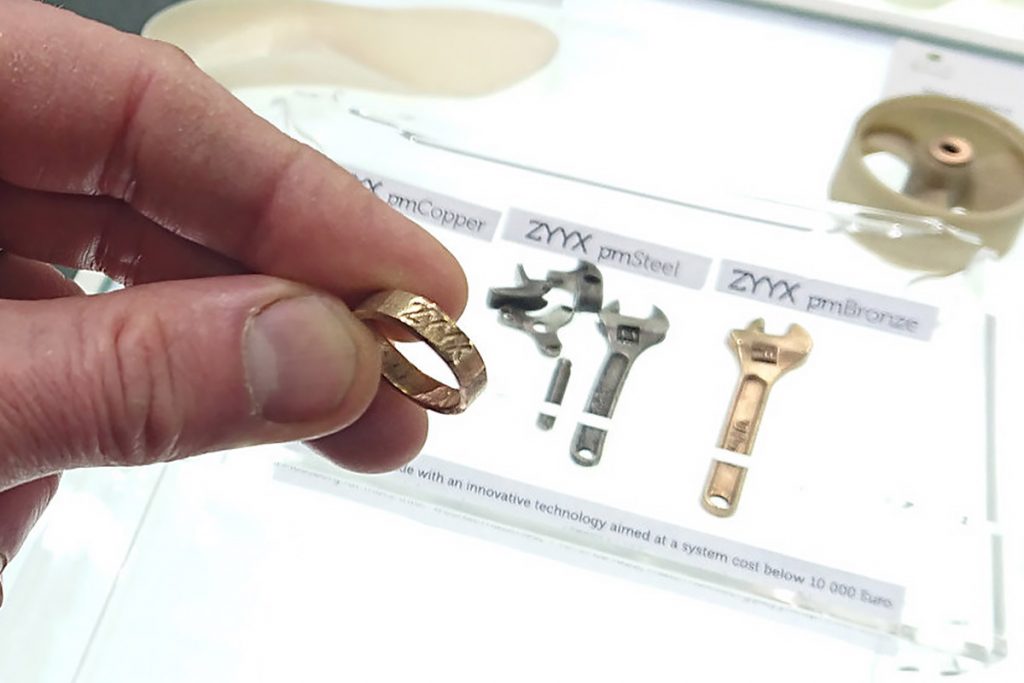Magicfirm Promises to Bring Metal Additive Manufacturing Costs Down with New ZYYX 3D Printer

Magicfirm Europe’s ZYYX metal printer combines metal powder with a binder, making it safe to handle and use without any special measures, opening the door for the system to be used in design and development work environments. These improvements, along with a significantly reduced price, bring 3D printing within reach of more businesses.
Latest News
April 4, 2018
Magicfirm Europe recently announced that it is developing a three-stage metal 3D printing system that it contends will take additive manufacturing (AM) into the mainstream, initially targeting applications like prototyping and end-use parts production. The Swedish company aims to reach the tipping point by going one step further than its competitors, with a price tag of less than $12,400. But the sticker price is just the tip of the iceberg.
The company says that the new printer’s enhanced safety, accessibility, and efficiency will significantly improve customers’ bottom lines. These benefits, it believes, will help sweep away market reticence and facilitate applications that have long been considered sweet spots for AM technology.
 Magicfirm Europe’s ZYYX metal printer combines metal powder with a binder, making it safe to handle and use without any special measures, opening the door for the system to be used in design and development work environments. These improvements, along with a significantly reduced price, could bring 3D printing within reach of more businesses.
Magicfirm Europe’s ZYYX metal printer combines metal powder with a binder, making it safe to handle and use without any special measures, opening the door for the system to be used in design and development work environments. These improvements, along with a significantly reduced price, could bring 3D printing within reach of more businesses.The Spare Parts Conundrum
But to get to that sweet spot, metal 3D printers must overcome a number of major hurdles. Making, storing, and shipping spare parts has long been a thorn in the side of businesses across the full range of industries, costing each organization time and money. Long an application in search of an efficient solution, maintaining inventories of infrequently ordered parts is often too expensive to be practical, forcing companies to choose between maintaining a costly service or alienating customers in need of replacement parts.Raising hopes for change, the advent of 3D printing promised to sweep aside all these problems, enabling suppliers to make parts on-demand locally — close to where the parts are needed — and revolutionizing product design in the process. Unfortunately, achieving this vision has proven to be elusive.
The fact is most professional organizations are aware of 3D printing as a prototyping tool and a means of producing parts, but few have fully embraced the technology. Why the reluctance? Most 3D printers are too expensive, too complex to operate, and cannot be deployed close to development and production teams because of safety and health risks.
Enter the Benchtop Metal 3D Printer
A vanguard of developers, however, has begun to attack these barriers. Companies like Markforged and Desktop Metal have launched benchtop metal 3D printers that promise to reduce complexity, streamline the production process, mitigate or eliminate safety issues, and reduce prices. Although these advances have made the technology more palatable for businesses, and the cost reductions represent a significant improvement, the price tags for metal printers still put the technology beyond the reach of many companies.This is where Magicfirm plans to make a difference, starting with a low price tag and then bringing down the total cost of ownership by making improvements in key areas like accessibility, safety, and simplicity. “In this application, the printing cost in itself is normally not the major expense, but instead, the overhead time in getting access to the printer and the complexity of using the printer will be the highest cost,” says Mats Moosberg, CEO of Magicfirm Europe. “The material cost for printing with our technology will be comparable with the current FDM-based [Fused Deposition Modeling] metal printing solutions, but the ease of use and accessibility will be much higher than the currently available competing solutions and therefore greatly reduce our customers costs in their product development processes.”
How Magicfirm’s System Works
Magicfirm has not yet released all of the details on its industrial-grade metal printer, but the company has provided a glimpse at a few of the system’s key features. The ZYYX metal printer (as it’s called internally by the development team) is similar to existing printing systems, such as selective laser melting and electron beam melting/binder jetting or filament-based metal printing technologies. Like these, it uses metal powder as the supply material. But the ZYYX metal printer’s metal powder is combined with a binder that makes it safe to handle and use without any special measures, according to the company. These two enhancements open the door for the system to safely and conveniently work on a desktop in design and development work environments.“Compared to other metal printing solutions, we have found a way to eliminate the need for any toxic substances in the processing steps leading up to getting the solid metal object,” says Moosberg. “We only use metal powder contained in a binder, which does not emit any metal particles or toxic fumes, providing a huge safety gain.”
Basically, the ZYYX metal printer works in three stages. In the first stage, the printer builds up the object — the so-called “green body” — which consists of loosely bound metal powder. Here, an FDM-like process can create high-resolution (about 50 micrometers) geometries that can contain voids and lattice structures.
Next, the system removes the binder to create the “brown body,” which essentially consists of a fragile metal powder object that contains small metal particles located close enough together that they can be sintered into solid metal. In this stage, the system uses nontoxic substances to remove the binder.
In the final stage, the system sinters the brown body, forming a solid metal part. The company says that it has implemented several techniques that simplify this part of the printing process compared with other systems, but it has not provided any details about these improvements.
Magicfirm states that objects created using this method will have “comparable resolution and mechanical properties” to results from existing filament-based solutions, even though the technology is different. The ZYYX metal printer currently sees “a sintering level of more than 98%, and experiences shrinkage of about 21%.”
Currently, the ZYYX metal printer works with copper, bronze, brass, and steel. Magicfirm says that it will expand the system’s metals portfolio as the technology progresses.
The company expects the three-step binder-based metal 3D printing system will become available as early as 2019.
Subscribe to our FREE magazine, FREE email newsletters or both!
Latest News






